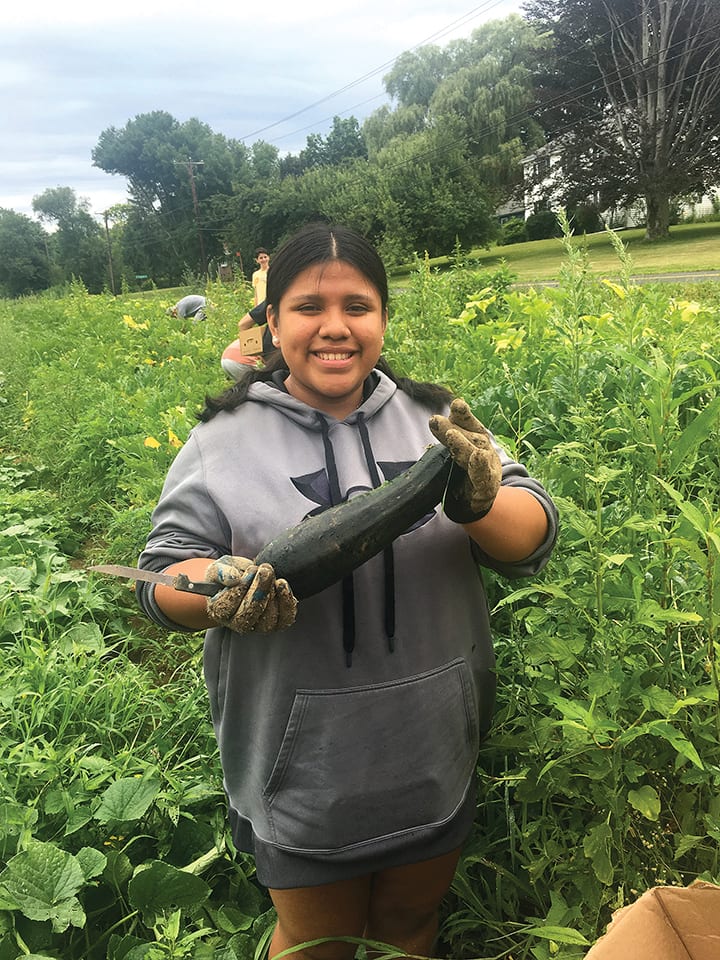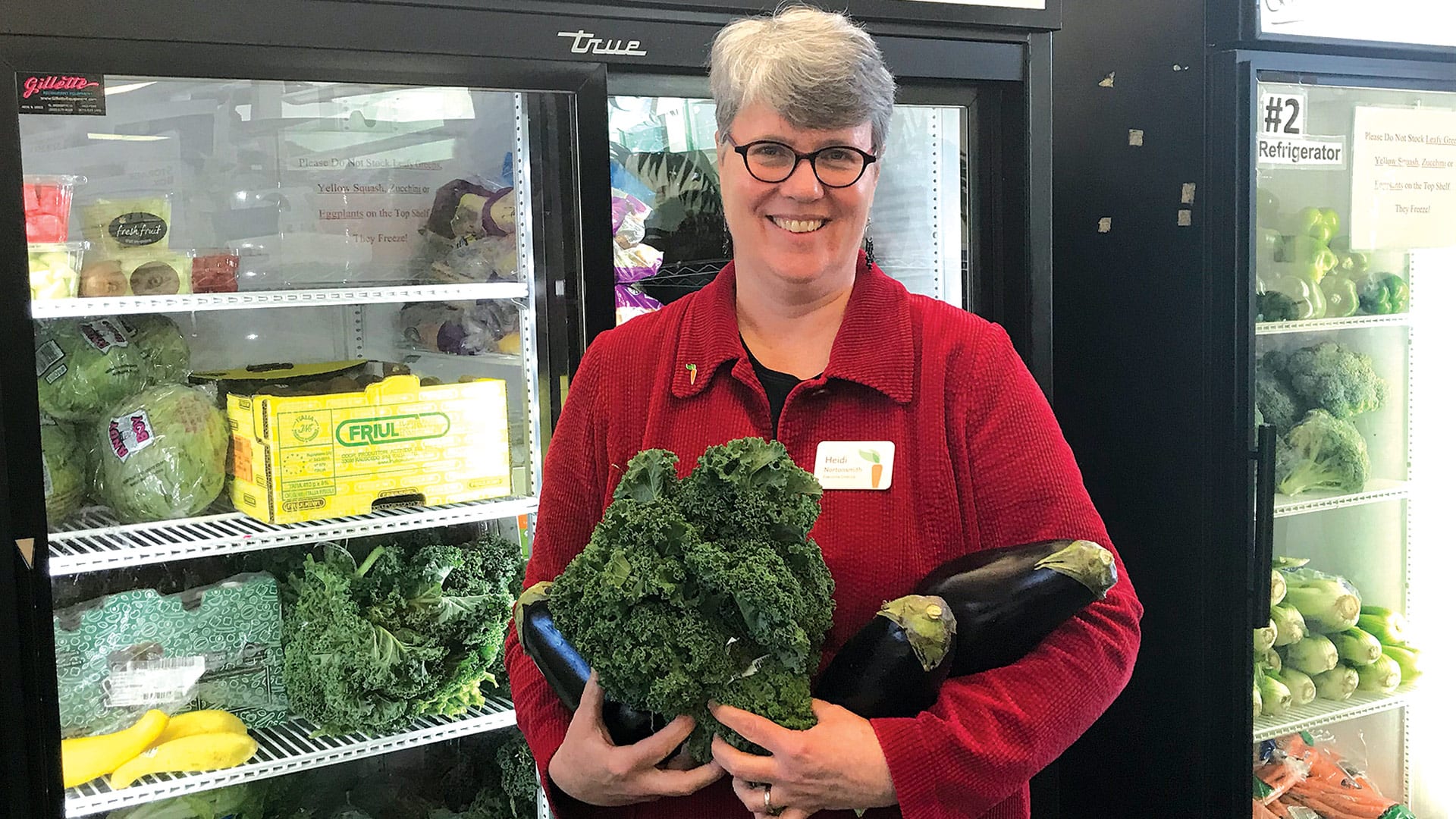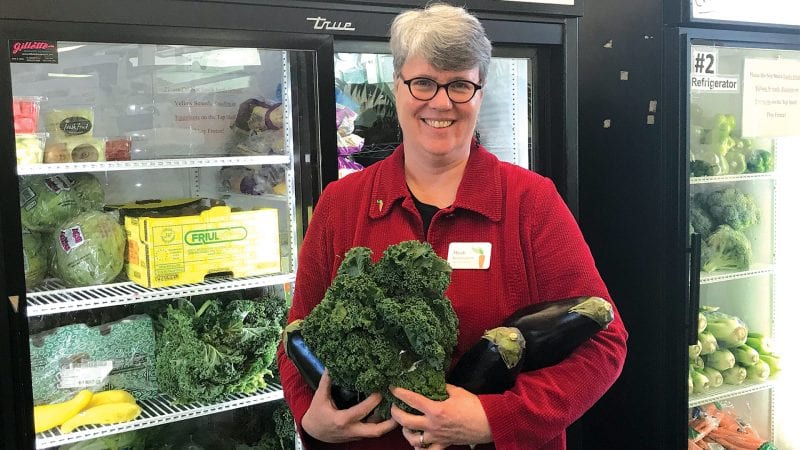Access to Healthy Food Identified as an Ongoing Challenge in Western Mass.
Crunching the Numbers
By Mark Morris
It sounds like a contradiction when someone who struggles with obesity still feels hungry all the time. The problem isn’t due to a lack of food, but instead a lack of nutritious food, which is often due to a situation known as food insecurity.
Feeding America, a hunger-relief organization made up of 200 food banks across the U.S., defines food insecurity as “lack of access to enough food for an active, healthy life for all household members and limited or uncertain availability of nutritionally adequate foods.” The group added that food insecurity may not affect a household all the time, but can appear at difficult times when paying for housing and medical bills takes priority over purchasing nutritious food.

Heidi Nortonsmith is executive director of Northampton Survival Center. Through its food pantry in Northampton and a smaller satellite pantry in Goshen, the center feeds between 90 and 100 people a day, five days a week. Nortonsmith has found that food insecurity often results from access issues, not a lack of food.
“Transportation access is a big issue,” she said. “If a person doesn’t own a car, they can’t take 40 pounds of food home on their bike or on the bus.”
Nortonsmith cited other barriers, such as language and special needs. For some, the inability to accept the reality that they need a food pantry can limit their access.
“The feeling of shame or injured pride can hold some people back,” she said. “This is often an issue for seniors who come from a generation that believes ‘I should be able to take care of myself.’”
A study from the U.S. Department of Agriculture found that food insecurity affects up to 11% of people nationwide. In Western Mass., that figure is 10%. More troubling, however, is the rate among children, where up to 14% in this area face food insecurity.
Dr. Estevan Garcia, a pediatrician and chief medical officer for Cooley Dickinson Health Care, said everyone needs good nutrition but for children, it’s even more essential because their bodies are still developing. Poor nutrition in the early years can negatively affect a child’s health for their entire lives.
“Chronic diseases such as diabetes, heart disease, and high blood pressure are starting earlier in children, all because of unhealthy eating and poor nutrition,” said Garcia, emphasizing that proper nutrition for children gives them the best chance for a healthy life. “When you have healthy children, it usually leads to healthy adults,” he told HCN.
“Transportation access is a big issue. If a person doesn’t own a car, they can’t take 40 pounds of food home on their bike or on the bus.”
Cooley Dickinson compiles a Community Needs Health Assessment (CNHA) every three years. The 2019 assessment listed healthy food access among the areas of concern. As a response, Cooley Dickinson has made a series of grants available specifically to agencies whose mission is to help connect people with fresh, healthy, and affordable food.
Jeff Harness, director of Community Health and Government Relations for Cooley Dickinson, said it’s important for a healthcare system to be involved in addressing the issues that affect people in the community.
“Whether it’s food, transportation, or housing, these all have an impact on health,” Harness said. “Sooner or later, problems in these areas end up in the emergency department.”
Another finding in the CNHA revealed pockets of food insecurity in Hampshire County ranging as high as 15%. Harness said this can be an issue especially in rural hilltowns such as Cummington and Plainfield, where a full-service grocery store can be more than 20 minutes away by car.
To address that challenge, Cooley Dickinson supported a recent pilot program by the community group Healthy Hampshire and Mass in Motion, a program under the Massachusetts Department of Public Health where mobile farmers’ markets visited seven different communities.

“This effort brought food to people, literally, where they live, and they were able to purchase nutritious food fresh off the truck,” Harness said.
Indeed, Healthy Hampshire surveys of participants before and after the mobile farmers’ markets showed significant increases in people saying how healthy they felt and in their confidence to meet daily food needs.
The Northampton Survival Center also received one of the Cooley Dickinson grants. Nortonsmith said it will use it to address the declining number of people using the agency’s Goshen pantry, which serves many of the hilltowns in the county. She admits it would be great news if the declining numbers were due to fewer people being food-insecure, but she suspects that’s not the case.
“We’re going to dig down to try to find out what’s really going on and to see how we can better meet the needs of the people in that area,” she told HCN.
Another organization that addresses food insecurity is Rachel’s Table. Located in Springfield, its motto is “Reduce waste. Relieve hunger.” Six days a week, more than 200 volunteers collect food from local supermarkets, restaurants, caterers, and other sites and deliver it to more than 40 organizations that help feed the hungry.
In addition to its daily efforts, the organization works with youth and school groups to collect fruits and vegetables through its ‘gleaning’ project. Jodi Falk, executive director of Rachel’s Table, explained that gleaning is collecting produce that’s left over after the harvest season.
“Often we collect the produce that’s not ‘pretty,’ or sometimes a farmer will over-produce in anticipation of a bad-weather season,” she said. Youth volunteers gather the produce and bring it to agencies that feed the hungry.
From midsummer to the first frost, Falk added, gleaning is a great way to increase the amount of fresh produce for those who rely on food pantries and other agencies.
“By going to the farm and gathering the fruits and vegetables, we’re working to remove a big access barrier for people.”
The gleaned vegetables go directly from local farms to food pantries in a day or two, a quicker turnaround than some grocery-store produce, which can take weeks to transport by truck.
Part of nutritious food delivery also means consistent access to dairy. Falk said Rachel’s Table has a year-round program to deliver milk to agencies that serve children.
While many families receive help from the federal Supplemental Nutrition Assistance Program (SNAP) and the Massachusetts-sponsored Healthy Incentives Program (HIP), both programs face funding issues every year. One of the more popular features of HIP allows recipients to double their spending power when they purchase fruits and vegetables.
Nortonsmith said her organization has a partnership with the Food Bank of Western Massachusetts that gives it tremendous buying power to stock the food pantries. In 2019, the Northampton Survival Center spent $185,000 to purchase $1.38 million worth of food.
As a result of that buying power, the pantry has been able to increase its fresh-food offerings. With the help of her staff, Nortonsmith has reconfigured the pantry to emphasize the healthy choices that are available.
“We changed the layout so all the fresh food items are the first things you see,” she said. “We’ve also added refrigeration units so it feels more like a supermarket experience.”
Just as there are many reasons for food insecurity in Western Mass., there are also a number of dedicated efforts to combat it. Harness noted that, when trying to solve challenges that involve public health, it’s best to look for multiple strategies.
“There is no one solution,” he said, “but instead many efforts that, when combined, add up to improving the health of our community.”



